MSI GT70 Review: GTX 880M Edition
by Jarred Walton on April 16, 2014 6:00 AM ESTMSI GT70 LCD Quality
I noted earlier that the GT70 display is merely “okay”, and here’s where you’ll see why I have such a mediocre opinion of the panel. It actually delivers good colors overall once you calibrate it, but out of the box the colors are horribly skewed towards the “cool” end of the spectrum, with highly oversaturated blues. I used our tablet display testing workflow to gather this image, showing a relative representation of what the colors on the GT70 look like out of the box compared to what they should look like (the "desired color" is on the bottom). Most devices you’ll see minor differences, but the tinting of the various colors is extremely noticeable on the GT70:
I’m not quite sure why so many displays have such inaccurate colors, but my best guess is that in order to hit higher maximum brightness values (e.g. 350 cd/m2 – or “nits” if you prefer), the LCD panel makers are just pushing the LED backlights as hard as they can. Most seem to end up with very blue tints, and rather than correct that via the LUTs and end up with a lower maximum brightness value, we get poor colors.
It’s not just the colors that are disappointing on the GT70 display, though. With tablets helping to pave the way, people are becoming more knowledgeable about display quality, and the poor viewing angles of TN panels are finally earning the scorn of consumers they deserve. Most Ultrabooks are now using IPS (or similar technology) panels, and while I don’t necessarily feel every laptop needs a high quality display, it’s pretty sad when $400-$500 tablets have substantially better displays than $2000 notebooks. Given the woes of Windows DPI scaling and the continuing lack of broad application support for High DPI displays, we may not need or want QHD or QHD+ panels on a 15.6” or 17.3” notebook, but a slightly higher quality 1080p display would certainly be nice.
Below are the galleries and charts for uncalibrated and calibrated colors on the GT70. We’ve switched our LCD testing to use CalMAN 5.3 with an i1 Display Pro spectrometer, which gives far better results than our previous testing using ColorEyes Display Pro with an i1 Display 2, so we can’t really compare older scores directly with the new results. However, the brightness, contrast, and gamut should all be within a few percent regardless of which testing method was used. What we see is that the MSI GT70 is at least a better display than the budget TN panels, but it’s definitely not one of the top displays these days. That’s not too surprising considering the actual panel appears to be the same as in previous GT70 notebooks, which means it’s now at least a few years old in terms of the core technology.
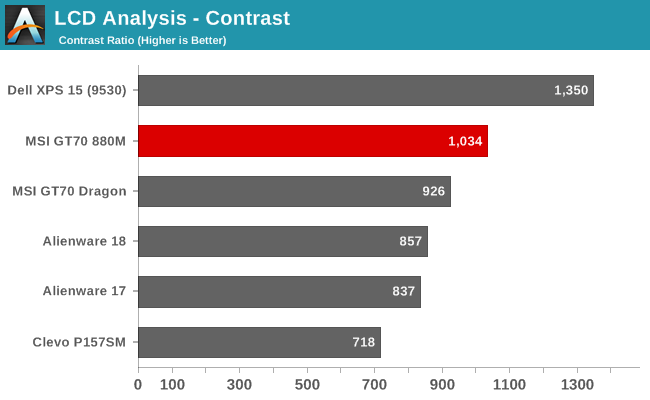

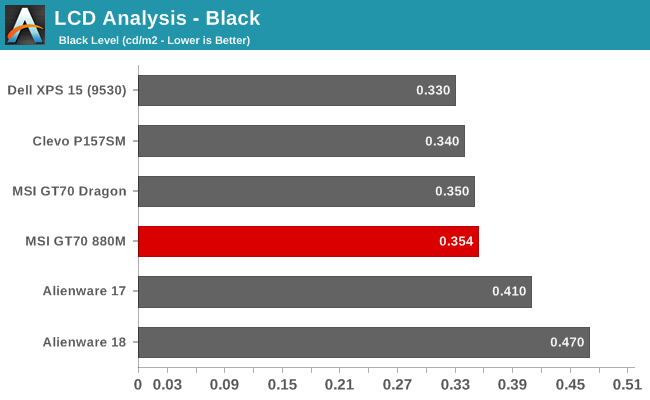
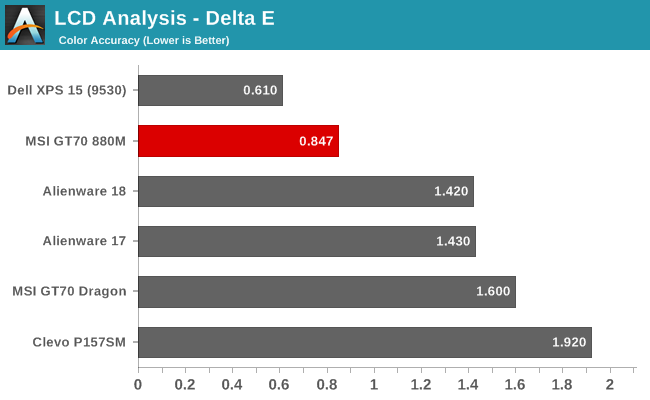
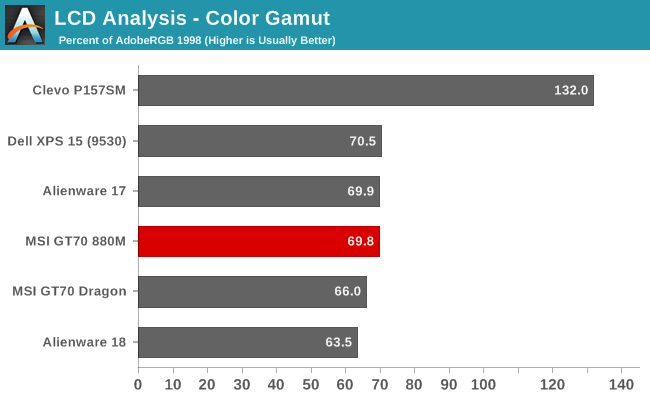
Overall, the display in MSI’s GT70 is certainly better than what you’ll find in budget notebooks and it will work well for gaming, but if you prefer higher quality displays you might just need to wait for the next round of updates and hopefully well see some IPS/AHVA/PLS or some other similar technology start showing up in the gaming notebooks. The colors can be calibrated to the point where they're quite good, but out of the box the display doesn't look very good at all.
















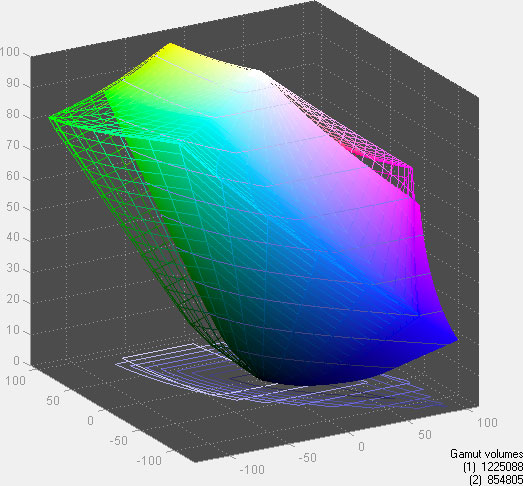








61 Comments
View All Comments
Hrel - Wednesday, April 16, 2014 - link
I've always wondered why laptop GPU's include so much extra GPU RAM. I've never seen a GTX660 with 4GB of RAM, much less 8. Yet I saw GTX460M's configured with 4GB of RAM years ago. What gives?Gunbuster - Wednesday, April 16, 2014 - link
It's a check box feature. That RAM is not that expensive and makes the system sound more impressive. It's not like they can stick a huge gaudy yellow three fan MSI cooler on the prefab graphics module they buy from Nvidia...ssiu - Wednesday, April 16, 2014 - link
And I always thought the 4GB on mobile GPUs are typos, since even desktop cards like 780Ti doesn't have 4GB. So they really have 4GB (and 8GB for this one)?? *mind blown*Batmeat - Wednesday, April 16, 2014 - link
I have the GE70. The machine is amazing. IMO save yourself the money and put your own SSD in. That's what I did.emarston - Thursday, April 17, 2014 - link
Same here, I popped in 2 SSDs in my GE70 and it's awesome.Harmattan - Wednesday, April 16, 2014 - link
Let's call this like it is... this is a 3 year-old laptop using a 1 1/2 year-old GPU. The 880m is the same exact chip as last year's 780m (which provides the same or better performance when overclocked) -- it's as if, in the desktop space, NVDA was to increase the GTX 780's core speed a bit and call it a "GTX 880". Further, the 880m is same chip as a 680m albeit with another shader block enabled. My issue is not the performance the 880m/780m provides, which is very good -- it's the fact that NVDA is sitting on tech and dribbling it out -- with virtually no cost improvement -- since there is no competition whatsoever at the high end. We need a high-end Maxwell mobile solution toute suite.Also, just a note on the pricing points you make at several points: this GT70 as configured is actually $50-100 more expensive than an NP8278/P170SM (which actually had some cosmetic changes since the last version, and has much better cooling) with the same hardware depending on the reseller -- not sure where you're pricing these machines...
Meaker10 - Wednesday, April 16, 2014 - link
Still has a much worse speaker setup and keyboard however.godlyatheist - Wednesday, April 16, 2014 - link
Where can you buy the i7-4700MQ 3 years ago? Oh wait, you can't.It's not a crime to use existing design and update them. They are faster (even if marginally) and not more expensive compared to the release price of the old gen equivalent. I don't get the problem here. It's not like they marketed the 680M laptop for $1000 and 880M ones for $2000.
"The 780m (which provides the same or better performance when overclocked)" That statement says the 880m improved because it is able to reach higher clock at same power envelope. You may think it's nothing, but you can't deny it's an improvement.
You said it yourself, there is no competition at the high end. Is it Nvidia's fault that AMD can't compete? Why should they do anything when refreshing existing design let's them reign with ease?
MSI has traditionally been weak in the cooling department, because they make budget gaming laptops. They are going to save the $$$ somewhere and cooling is what MSI chose. If you only care about specs, sure go with Sager/Clevo. All the other stuff surely aren't worth $50-100 right?
I have the P150HM/NP8150 with 2nd gen i7 + 680M and it runs any game I need comfortably. It has a dual fan design yet the cooling is crap unless you mod the casing. The reason is thin heatpipe and lack of air intake. Clevo has improved since then but it's the same as any other company. Oh yea, the keyboard is junk on it.
danwat1234 - Tuesday, April 22, 2014 - link
The MSI has a very high flow 12V cooling fan. If you crank the fan to full speed, temps will stay nice even at full load on all processors. Unless it's needs a repaste.pmpysz - Wednesday, April 16, 2014 - link
"ASUS is now using an IPS panel in their competing G750 series"What model? I've been looking at them all and haven't seen a single IPS panel in any of the G750s. Even the new ones with the 800 series GPUs.